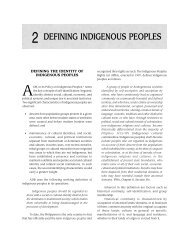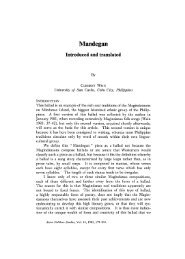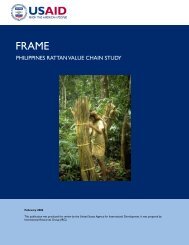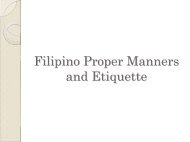STUDIES IN PHILIPPINE LANGUAGES & CULTURES
STUDIES IN PHILIPPINE LANGUAGES & CULTURES
STUDIES IN PHILIPPINE LANGUAGES & CULTURES
Create successful ePaper yourself
Turn your PDF publications into a flip-book with our unique Google optimized e-Paper software.
<strong>STUDIES</strong> <strong>IN</strong> PHILIPP<strong>IN</strong>E<strong>LANGUAGES</strong> & <strong>CULTURES</strong>Supplementary SeriesNo. 4 1987Guinaang Kalinga textsC. Richard Gieser, comp.; Fe T. Otanes, Austin Hale, series eds.21. Kadawiyan di bagunson / Funeral customsIrenio M. Wansi88–92ISSN 0116-0516 ISBN 971-1059-08-8© L<strong>IN</strong>GUISTIC SOCIETY OF THE PHILIPP<strong>IN</strong>ES and SUMMER <strong>IN</strong>STITUTE OF L<strong>IN</strong>GUISTICSSample Citation FormatMa. Lourdes S. Bautista. 1977. “The noun phrase in Tagalog—English code switching”. Studies inPhilippine Linguistics 1:1, 1–16. Online. URL: http://www.sil.org/asia/philippines/ [etc.] + access date.
88 Guinaang Kalinga Texts21 KADAWIYAN Dl BAGUNGONcustoms PO funeralFUNERAL CUSTOMSby Irenio M. Wansi1. No awad matoy si tagu ipauydaCOND EXT die REP person shout.theyon mandatdatong dan tagu on mangwa sinLK gather.together T person LK make OBJ*bawi ad asidaot bumaun si tagutemp.shelter SEQ FUT.they,SEQ send OBJ personon iaoy mangipauy si.dan ilin odum onLK go shout REP village.LK other LKanda on natoy si anua. 2. No naganputsay,they LK died T So.and.so COND finisheddi nambaunda si imoy mangala si03 send.they OBJ go get OB J1. When a persondies, they shout forpeople to gather tomake the temporaryshelter, and then theysend persons to goshout to the othervillages. saying."So-and-so has died."2. When that has beendone, they send(persons) to go getsugar cane wine,carabaos, unhuskedrice, and other thingsthat are necessary.bayas luwang pagoy adsugar.cane.wine carabao unhusked.rice CONJodum on masapul.other LK necessary3. Mandatdatong dan tagu.gather.together T person4. Man'iinumda. 5. Mambayuda dancont.drink.they pound.in.mortar.they DETbubai. 6. Otoyonda ad nan luwang iniwadafemale kil1,they SUB T carabao cut.up.theyad iwwatwatda. 7. Mabualda danSEQ distributed,they disperse,they DETtagu ad asidabos mandatdatong noperson SEQ FUT,they,again gather.together COND3. (For the funeral)the people gather together.4. They drink.5. The women pound(rice) in mortars.6. *When they kill acarabao, they butcher(it), and then theydistribute (it).7. The people disperseand then gather againat night when theyprepare the animalfor the people to eat.labi no mangwada' adamalnight COND do,they,OBJ animal.killed.at.night
Funeral Customs 89si anon dan tagu.REP eat NTS person8. Ad no mabigat padana onSEQ COND next.day same.its LKmampaltida si luwang adbutcher-they OBJ carabao SEQitipoyda.use.as.food.eaten.with.rlce.they9. Iwwatwatda nan nabun'an on issa pondistributed.they T remainder LK NEG,it APnitipoy.used.as.food.eaten.with.rice10. Mallobondabury. theyno naganputda mangan ad nabualdaCOND finished,they eat SEQ dispersed,they8. And the next day,in the same way, theybutcher a carabao, andthen they use it forthe food that is eatenwith rice. 9. Theydistribute what isleft over, which wasnot eaten (at thegathering). 10. Theybury (the deceased)when they havefinished eating, andthen the peopledisperse.dan tagu.DET person11. No bagungon di ba'nang11. At a funeral forCOND funeral PO rich.persona rich person. theygive gifts, or theymawwalitda onno mampolaisdagive money; theygive.gifts,they or give.money.theypurposely put unhuskedrice on the groundmandon'a'daad(around the wine jarspurposely.put.rice.on.ground,they SEQand the death chair);and they butchermanggusbuda in. sigun si kaadun (animals) according tobutcher.animals,they according.to DET number, * the number of carabaosdi luwang on mabalinda. 12. No adunPO carabao LK neans.their COND much,Tbinanyagaana sin nataguwana iyomolprofited,he TI lifetime,his raise.a.clamordan tagu on mampa'wada siNTS person LK cause.s.t.to.be.done.they REFalobbongan di impadas din natoy.status PO accomplished NTS deceasedthat they (i.e., thefamily) can afford.12. If he (thedeceased) profitedmuch during hislifetime, the peopleraise a clamor to get(the family of thedeceased) to doaccording to thestatus the deceasedhad attained.
90 Guinaang Kalinga Texts13. Dan mabaun on imoy mangalat.danST be.sent LK go get.OBJluwang on nansilbi sin natoy dida nancarabao LK to.be.used REF deceased they DETmangintuwa'.nan palagpag din luwang ontake.possession.of,REP breast PO carabao LKalanda. 14. Matongyabanad danget, they be.kil1ed.by.slash.to.neck SUB Tluwang no awad mabalin dancarabao COND EXT means POnatoyan sa'bunganda si ulos onnofamily.of.deceased cover.they REP blanket or13. The persons sentto go get the carabaosused for the deceasedare the ones whotake possession of thebreast of the carabaothey (went to) get.14. *When the carabaosare to be killed, ifthe family of thedeceased has themeans, they cover (theback of the carabao)with a blanket, orthey give money to theperson who kills thecarabao.pilak nan iddondal.danmoney DET give,they.REFmanongyab.one.who.kills.carabao.by.slashing.neck15. No mampatumangad danCOND have.ceremonia1.drinking Tnatoyan mawwalagda' tabaofamily.of.deceased distribute,they,OBJ tobaccoowigo onno pilak nanglonat.dan malloswat sinmatches or money especially.DET remove OBJsa'bung din maltaba.covering PO k.o.large.receptac1e16. Al'altiyanda no odumna no dawatembellish,they COND sometimes COND requestdi amina naanung.PO al1,LK attending.gathering15. *If the familyof the deceasedinclude ceremonialdrinking of sugar canewine in the program.they distributetobacco, matches, ormoney, especially tothe ones who removethe covering from thelarge receptacle(containing the wine).16. They embellish(the program)sometimes, if it isrequested by all whoare attending thegathering.17. No awad manopla' sin 17. When someoneCOND EXT one.who.breaks.mortar REP breaks a mortar in theceremonial pounding of*itlittong iddanda ' pilak rice, they give (thatceremonia1.rice.pounding give.to,they.DET money person) money, or ablanket. a valuable
Funeral Customs 91onno ulos panay ain an odum plate, a skirt, andor blanket valuable.plate skirt CONJ other other additionalthings they want topayyana piyaonda igunguna sin use as prizes for aadditiona1,LK want.they give.as.prize REPmanopla' .one.who.breaks.mortarperson who breaks amortar.18. No lusnun di mal'ima' 18. For the servingCOND serving PO k.o.glutinous.rice of mal-in&, they alsogive prizes if themagungunaandabos no awad mabalin family of the deceasedbe.given.a.prize.they.also COND EXT means have the means to givethem.dan natoyansi iddonda.PO faai1y.of.deceased REP give.they19. No ba'nang nan matoy aminaCOND rich.person T dies all.LKoonan kadawiyan di bagungon ondoes.he.DET customs PO funeral LKmansabsabalin kadawiyan di gimpong an odumPL,different.LK customs PO Kalinga CONJ otherpayyana kadawiyan dan kaitnogan.additiona1,LK customs PO Tingguian19. When the deceasedis a richperson, (the oneholding the bagungon)does all the customsof the Kalingas andother customs of theTingguians in addition.Ethnographic and Linguistic Notes on FUNERAL CUSTOMS1. bdwi'temporary shelter'. To make a b6wi, two or more posts, five or sixfeet in length, are placed at a distance from a house where a death hasoccurred (usually from the front of the house). The size of the area to besheltered depends upon the number of people expected to attend theobservance. After the posts are in place, a crosspiece is tied with rattanacross the posts next to their tops. Then, longer members are placed withone end resting on this crosspiece and the other on a higher member that issecured to the wall of the house. Then, crosspieces are placed atintervals across these upward sloping members to support sheets ofcorrugated metal roofing. In olden times, layers of wild banana trees(buw~) were used for the roofing of a ha. The men sit under this shelterfor the duration of the death observance, which lasts until after thecorpse has been interred in a tomb (see text 22) or a grave. The women sitinside the house, where the body has been placed in a sitting position on asang6dil 'death chair' made especially for the observance. The corpseremains on this chair until it is taken to be interred.
92 Guinaang Kalinga Texts6. For this distribution. the meat is cut into pieces and put on bamboostrips (pising) to facilitate carrying it. Shares of neat are given toevery family represented except the family and relatives of the deceased.14. The customary way of killing carabaos at death observances is by- tonay6b. The man (manonriybb) doing it holds a length of rattan ( i m thathas been attached to the animal's nose. He grasps this rattan close to theanimal's nose so that he can elevate its head, tightening the skin of theneck and giving him a clear swing. Then he swings his bolo (baddng) toslash the animal's neck and cut the jugular vein. If the man selected isstrong and skilled and has a well-sharpened bolo, one swing is usually allthat is needed to kill the animal. Nevertheless, in order to be prepared incase the first swing is not fatal, they attach ropes to the carabao's feetbefore there is any effort to kill it. These ropes are held by young menwho will pull on them if necessary to prevent the animal from getting away.This is not as humane as a single fatal stroke.15. At funerals for members of families who have means, ceremonial drinkingof sugar cane wine (tumtlnnad) is part of the program. In Guinaang, thedrink for tumangad may be presented in either of two ways: (1) in a largecast iron receptacle (maltab6) set on the ground, or (2) in a number ofvaluable dishes placed on a board laid across two mortars. In both cases,the drink is placed in the center of the gathering. The first way ismentioned in this text. The large container, having been filled, is coveredwith a blanket. When the event is about to begin, the blanket is removed bya selected individual, who is then rewarded with some money for hisservice. After the covering has been removed or, in the second case, afterthe dishes have been filled, leading men of the different villagesrepresented are called by threes or fours to go forward and drink. Theperson gets down with his face to the wine; then he proceeds to drink.(This is the way that commands the respect of others present, but, in thecase of the individual dishes, some hold the dish in their hands and drinkfrom it in the usual manner.) After a man has finished drinking, he isgiven some money. After the leaders have all had their turns, the other menin attendance are given opportunity. As part of the tumangad custom,tobacco and matches are also usually distributed to all the men present.17. it-it-& 'ceremonial pounding of rice'. For this activity, a sort oftrdugh is made where a number of mortars are placed side by side. Certainwomen are chosen to participate, and the one who succeeds in breaking hermortar is given a prize.
















